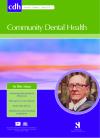Community Dental Health

- Cover Date:
- March 2013
- Print ISSN:
- 0265 539X
- Vol:
- 30
- Issue:
- 1
Caries experience and treatment need in adults with intellectual disabilities in two German regions
doi:10.1922/CDH_2999Schulte06
Objective: The aim of the study was to determine the caries experience, caries prevalence, dental treatment need and care index of adults with intellectual disabilities living in the German federal states of Baden-Württemberg and Sachsen which differ distinctly with respect to the socio-economic conditions. Research Design: In 2007, legal custodians of all persons working in special day-care institutions (n=2037) were asked to give consent for dental examinations of their custodees. Some 21.9% consented. Thus, 428 persons received a dental examination in the day-care institutions. Results: The mean age of the participants was 35.5 years (range 18–64). Caries prevalence was 93.7% (95% CI 91.3–95.9) in Baden-Württemberg and 97.6% (95% CI 96.2–99.0) in Sachsen. All caries-free persons (n=19) were younger than 35 years. The mean DMFT of the whole sample was 12.3 (95% CI 11.6–12.9). Although DMFT values were the same in both German regions, persons from Baden-Württemberg had more missing teeth than those from Sachsen but untreated carious defects were more common in Sachsen. Conclusions: Dental care for those with intellectual disabilities could be better harmonised within Germany. Furthermore, specific dental care and dental treatment strategies could be introduced in Germany in order to reduce caries prevalence and number of extracted teeth in persons with intellectual disabilities.
Key words: oral health, intellectual disability, dental caries, dental treatment need
- Article Price
- £15.00
- Institution Article Price
- £
- Page Start
- 39
- Page End
- 44
- Authors
- A.G. Schulte, K. Freyer, A. Bissar
Articles from this issue
- Title
- Pg. Start
- Pg. End
- Editorial - The British Association for the Study of Community Dentistry at forty: our professional project
- 2
- 4
- Dental Public Health in Action - Challenges encountered when conducting a dental health needs assessment of older people resident in care homes: experience from England
- 6
- 9
- Fluoridation and dental caries severity in young children treated under general anaesthesia: an analysis of treatment records in a 10-year case series
- 15
- 18
- Attitudes towards the use of fluorides for oral health among Islamic clerics in Kelantan Province, Malaysia
- 30
- 33
- The views of examiners on the use of intra-oral photographs to detect dental caries in epidemiological studies
- 34
- 38
- Caries experience and treatment need in adults with intellectual disabilities in two German regions
- 39
- 44
- Attitudes towards establishing a daily supervised school-based toothbrushing programme - determined by Q-sort methodology
- 45
- 51
